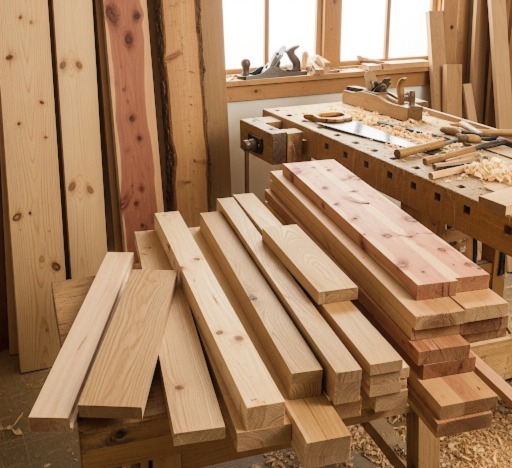
Which Wood is Used for Carpentry is one of the oldest and most important skills in home improvement, furniture making, and interior design. The quality, durability, and look of wooden products depend largely on the type of wood used. At Glorious Service, we understand that selecting the right wood is the first and most important step to ensuring your carpentry project stands the test of time.
Different types of wood are suitable for different purposes—some are perfect for heavy furniture, others for decorative items, and some for outdoor structures. This guide explains the most common types of wood used in carpentry, their features, and where they are best applied.
1. Hardwood vs Softwood – The Basic Difference
Before looking at specific wood types, it’s important to understand the two main categories of wood:
- Hardwood: Comes from deciduous trees (trees that lose leaves seasonally). It is generally denser, stronger, and more durable. Common examples include teak, oak, mahogany, and maple. Hardwood is ideal for high-quality furniture, doors, and flooring.
- Softwood: Comes from coniferous trees (evergreens with needles). It is lighter, easier to work with, and more affordable. Examples include pine, cedar, and spruce. Softwood is commonly used for frames, shelving, and paneling.
At Glorious Service, we choose between hardwood and softwood based on the project’s purpose, budget, and style requirements.
2. Popular Types of Wood for Carpentry
a) Teak Wood
- Properties: Known for its golden-brown color, natural oil content, and resistance to termites and water damage.
- Uses: Ideal for premium furniture, doors, and outdoor carpentry.
- Why Glorious Service Recommends It: Teak’s durability makes it a long-term investment, perfect for both indoor and outdoor applications.
b) Oak Wood
- Properties: Strong, heavy, and attractive grain pattern. Available in red and white varieties.
- Uses: Flooring, cabinetry, and high-quality furniture.
- Why Glorious Service Recommends It: Oak is perfect for projects where strength and visual appeal are equally important.
c) Pine Wood
- Properties: Softwood with a light color, easy to cut, and budget-friendly.
- Uses: Shelves, frames, and lightweight furniture.
- Why Glorious Service Recommends It: Pine is excellent for projects that require quick installation and lower costs without compromising on look.
d) Mahogany
- Properties: Reddish-brown hardwood with excellent resistance to warping and shrinkage.
- Uses: Fine furniture, decorative paneling, and musical instruments.
- Why Glorious Service Recommends It: Mahogany brings a luxurious, rich finish to interiors.
e) Maple
- Properties: Dense, durable, and resistant to abrasion.
- Uses: Kitchen cabinets, countertops, and sturdy furniture.
- Why Glorious Service Recommends It: Its smooth finish and ability to take stains well make it a favorite for custom carpentry.
f) Cedar
- Properties: Softwood with a pleasant aroma, naturally resistant to insects and decay.
- Uses: Outdoor furniture, closets, and garden structures.
- Why Glorious Service Recommends It: Cedar’s weather resistance makes it perfect for outdoor and moisture-prone areas.
g) Sheesham (Indian Rosewood)
- Properties: Richly grained hardwood with high strength.
- Uses: Traditional Indian furniture, carvings, and decorative items.
- Why Glorious Service Recommends It: Sheesham offers a blend of beauty, strength, and cultural appeal.
3. Factors to Consider When Choosing Wood for Carpentry
At Glorious Service, we select wood based on a detailed understanding of your needs. Some key factors include:
- Purpose of the Project – Heavy furniture requires hardwood; light frames can use softwood.
- Budget – High-end woods like teak and mahogany cost more but last longer.
- Location – Outdoor carpentry needs weather-resistant wood like cedar or teak.
- Aesthetics – Grain pattern, color, and texture play a big role in interior appeal.
- Maintenance Needs – Some woods require more care, polishing, or sealing.
4. Treated vs. Untreated Wood
- Treated Wood: Chemically processed to resist insects, moisture, and decay. Best for outdoor projects.
- Untreated Wood: Natural and eco-friendly but may require extra protection. Ideal for indoor furniture.
At Glorious Service, we use advanced treatment methods when needed, ensuring the wood lasts for decades.
5. Sustainable and Eco-Friendly Choices
The carpentry industry is moving towards eco-friendly wood options like bamboo and reclaimed wood. These options reduce environmental impact while offering excellent durability and style. Glorious Service supports sustainable carpentry practices to protect the environment for future generations.
6. Why Glorious Service is the Right Choice for Carpentry
Choosing the right wood is important, but having experienced professionals handle the work is even more crucial. Glorious Service offers:
- Expertise in selecting the perfect wood for each project.
- Skilled craftsmanship to bring out the best in the chosen material.
- Affordable pricing without compromising on quality.
- A commitment to durability, style, and customer satisfaction.
Choose can transform your carpentry project.
The type of wood you choose can transform your carpentry project from ordinary to extraordinary. Whether you need long-lasting teak, budget-friendly pine, or luxurious mahogany, Glorious Service can guide you to the perfect choice. Our expertise ensures that every project is not only beautiful but also built to last.
